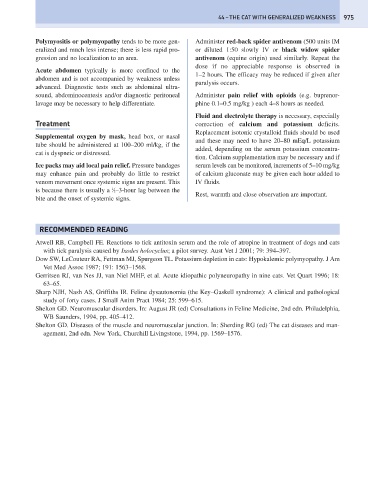Page 983 - Problem-Based Feline Medicine
P. 983
44 – THE CAT WITH GENERALIZED WEAKNESS 975
Polymyositis or polymyopathy tends to be more gen- Administer red-back spider antivenom (500 units IM
eralized and much less intense; there is less rapid pro- or diluted 1:50 slowly IV or black widow spider
gression and no localization to an area. antivenom (equine origin) used similarly. Repeat the
dose if no appreciable response is observed in
Acute abdomen typically is more confined to the
1–2 hours. The efficacy may be reduced if given after
abdomen and is not accompanied by weakness unless
paralysis occurs.
advanced. Diagnostic tests such as abdominal ultra-
sound, abdominocentesis and/or diagnostic peritoneal Administer pain relief with opioids (e.g. buprenor-
lavage may be necessary to help differentiate. phine 0.1–0.5 mg/kg ) each 4–8 hours as needed.
Fluid and electrolyte therapy is necessary, especially
Treatment correction of calcium and potassium deficits.
Replacement isotonic crystalloid fluids should be used
Supplemental oxygen by mask, head box, or nasal
and these may need to have 20–80 mEq/L potassium
tube should be administered at 100–200 ml/kg, if the
added, depending on the serum potassium concentra-
cat is dyspneic or distressed.
tion. Calcium supplementation may be necessary and if
Ice packs may aid local pain relief. Pressure bandages serum levels can be monitored, increments of 5–10 mg/kg
may enhance pain and probably do little to restrict of calcium gluconate may be given each hour added to
venom movement once systemic signs are present. This IV fluids.
1
is because there is usually a ⁄2–3-hour lag between the
Rest, warmth and close observation are important.
bite and the onset of systemic signs.
RECOMMENDED READING
Atwell RB, Campbell FE. Reactions to tick antitoxin serum and the role of atropine in treatment of dogs and cats
with tick paralysis caused by Ixodes holocyclus; a pilot survey. Aust Vet J 2001; 79: 394–397.
Dow SW, LeCouteur RA, Fettman MJ, Spurgeon TL. Potassium depletion in cats: Hypokalemic polymyopathy. J Am
Vet Med Assoc 1987; 191: 1563–1568.
Gerritsen RJ, van Nes JJ, van Niel MHF, et al. Acute idiopathic polyneuropathy in nine cats. Vet Quart 1996; 18:
63–65.
Sharp NJH, Nash AS, Griffiths IR. Feline dysautonomia (the Key–Gaskell syndrome): A clinical and pathological
study of forty cases. J Small Anim Pract 1984; 25: 599–615.
Shelton GD. Neuromuscular disorders. In: August JR (ed) Consultations in Feline Medicine, 2nd edn. Philadelphia,
WB Saunders, 1994, pp. 405–412.
Shelton GD. Diseases of the muscle and neuromuscular junction. In: Sherding RG (ed) The cat diseases and man-
agement, 2nd edn. New York, Churchill Livingstone, 1994, pp. 1569–1576.

